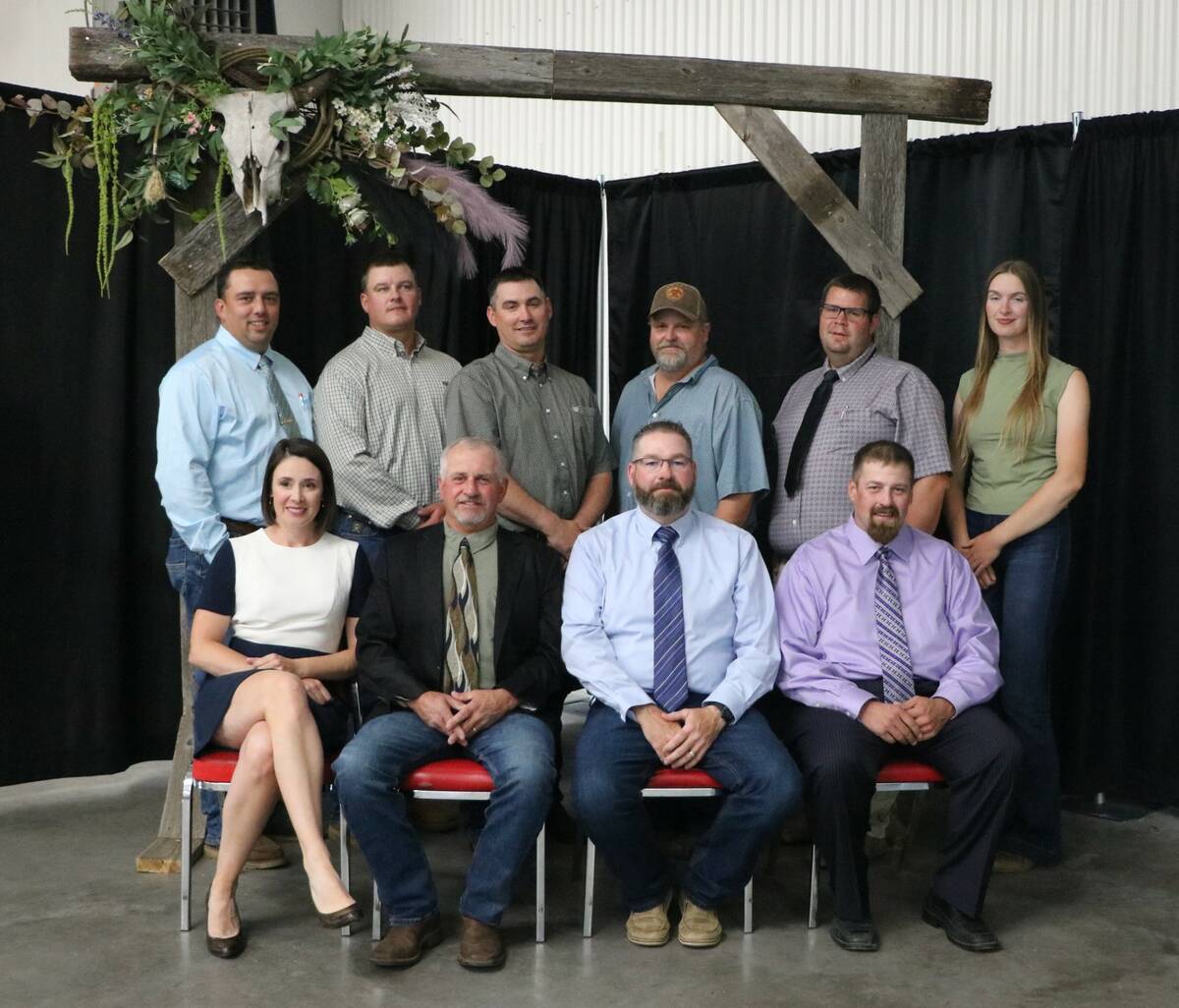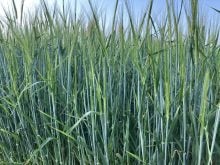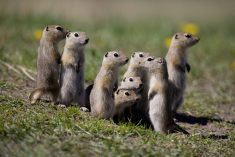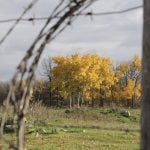Ranching in the middle of central Alberta’s grain country, with inches-deep topsoil and flat, open fields, may not be traditional cattle country, but it has worked for the Solverson family for more than a century.
Ranching amongst their mainly grain farming neighbours does have its benefits, said brothers Dave and Ken Solverson of Camrose, Alta.
Consistent access to cereal straw, pea straw, feed grain, screenings and hailed out cereal crops are key to developing inexpensive rations for their 1,000-head cow herd and offspring that are fed at their Woodwind Ranch until they are finished and shipped direct to the packers.
This winter, a group of cows were fed a mixture of pea straw and brewer’s mash in a nearby field. “These cows in their second trimester don’t need a lot of high-quality feed and we can get a quite economical winter ration using pea straw and grain,” said Dave, the former head of the Canadian Cattlemen’s Association from 2014 to 2016.
Read Also

Purely Purebred: Outstanding Young Angus Breeder, Junior Limousin Herd Building Incentive winners and more
News from Canada’s purebred beef industry, including show results, board election results, research and more
The family doesn’t grow peas but instead buys straw from neighbours. In years of heavy straw crops, grain farmers are often looking to get rid of the straw on their fields and the Solversons move in with their equipment and start to bale.
“I always make sure I pay them something for it so that in years we need it, they are looking after us. It has really worked out,” said Ken.

Competing with grain farmers for land to rent or buy gets a bit trickier. With a land base of about 3,000 acres — a combination of rented and owned land and rolling pasture along the Battle River Valley — the family has a stable base for their cattle operation.
“It is difficult to justify buying land at the price. If you have secure arrangements with your landlords, it is cheaper than owning it. We try to keep current with market value. You don’t want to set the market, but you should be pretty close. We have tried to do that,” said Ken.
The Battle River Valley has been home to the Solverson family since the late 1800s. Ken and Dave’s great great-uncle, George Bush, started the ranch along the river valley, raising the brother’s grandmother. But a market collapse in 1919 from the flu epidemic reduced the ranch to a few river lots. Along the Battle River, land is divided into long, narrow sections from the river to the top of the valley.
The family continued to farm in the area and when their father, Bill, returned from the merchant marines in 1948 after the Second World War, he used money from the Veterans Land Act, along with the sale of land for CFCW’s radio towers, to expand the ranch.
“He stepped out and bought 800 acres at one crack in 1962 and that was kind of unheard of,” said Ken.
In the 1980s the brothers expanded once again for their ever-growing cow herd. About half of the cow herd is trucked to two public grazing reserves and one private grazing reserve in the summer. For almost 40 years, they have shipped cattle to grazing reserves near Drayton Valley and Winfield, about a two-hour drive west. A private pasture near Opal, about the same distance north, has been a recent addition and has worked out well.
“Joanne gets our cows so quiet and manageable. That was one of the reasons he (the private pasture operator) likes our cows, because they are easier to handle,” said Dave, of his daughter.
The family’s cattle and grain operations are roughly divided. Ken and his son-in-law, Tyler Cameron, look after the grain farm’s seeding, harvesting and spraying. Dave and his daughter, Joanne Solverson, are in charge of the cattle, including marketing, feeding and health. Those roles blur during the busy seasons with everyone pitching in during calving, haying, silage and seeding.
“Everyone has their areas of strength, but we help each other out,” said Joanne, who said it wasn’t difficult to choose between her off-farm job or full-time on the farm. “That is my passion.”
Being on the ranch, where she grew up, is a life her two children have also embraced by helping out on the farm after school and enjoying the freedom known to farm kids.

When Tyler joined the farm after years of the highs and lows of oilfield and construction jobs, he promised his father-in-law that if he didn’t like it, he would quit and not feel obligated to stay involved in the family operation. Five years later he is still on the farm.
“Tyler keeps the place running. He fixes everything we break,” said Ken, adding Tyler helps out more each year with agronomy, spraying and cattle handling.
While Dave and Ken are still in senior management roles, Dave said without Joanne and Tyler playing an active role, they wouldn’t have a 1,000-head cow herd but have a dramatically scaled-back herd.
Last year Joanne signed herself up for an ultrasound pregnancy checking course and now is responsible for pregnancy checking the cattle herd with the help of the local veterinarian.
“Our vet, he supported me and helped train me and we bought the ultrasound from him. In the first year, I put the ones I was unsure of in a pen and had him do the retest. Instead of having him look at 600, we can have him look at 60,” she said.
Through the ultrasound app, the veterinarian can also link his phone to the pregnancy-checking goggles and see the same ultrasound image as Joanne, telling her how to adjust the wand to get a better image on the screen.
“It is getting better the second year,” she said.
Finishing their calves in their own feedlot instead of selling them as calves or yearlings has also set apart the Solversons from other producers. Since the 1990s the family have kept their calves to be finished on the farm. With a large cow herd of mainly Angus-Simmental cross cattle, it is easy to send a full load of uniform, finished cattle to the packers. But mostly, the family has figured out that adding the last 500 pounds onto the cattle is the easiest.
“They’re done getting sick and trying to die on you. Basically, you maintain them, feed them and water them. If your vaccination program is up to date there are not many health issues,” said Ken.
The family also raises a small herd of purebred Angus to produce their own herd bulls. Ken and Dave’s father raised purebred Hereford, but when the family expanded its land base, they exited the purebred business and focused on commercial cattle.
Being able to see the steers at different stages of finishing gives potential heifer buyers an idea of the uniformity of the herd, said Dave. In the last year, four of the five heifer buyers were repeat customers who liked the quality of the cattle and the calves they produced.
“Our herd has never been better,” said Ken.
As a general rule, the family keeps all the cows when they return from pasture in the fall and culls the open cows at breeding time. In an attempt to keep a uniform and youthful cow herd, the family culls the cows heavily for three main criteria: attitude, udders and age.
“It is so much easier to have cows you can handle,” said Ken, who said cranky cows don’t get a second chance. With strong prices in recent years, the family set aside 100 cows last year to be sold just to capture the high prices.
“The prices were strong, but partly we did it to protect ourselves from missing another peak. We didn’t want to keep building our inventory and watch it lose value,” said Ken, the farm’s chief financial officer.
Strong prices have made it easier to be in the cattle business. Thumbing through some old receipts, Dave said three years ago they sold a load of cattle to Lakeside for $222 on the rail. A group of similar kind and weight of cattle this fall brought $420 on the rail. To put it another way, five years ago a liner load of fat cattle ranged from $85,000 to $95,000. The last two loads, the same weight, brought between $155,000 and $165,000.
“The price is pretty darn good,” said Dave, who recently hedged prices for February delivery, capturing their best prices ever.
Over the years the family has developed a unique tagging system to help identify the age of the cattle. Instead of using the letter system like the purebred industry, the ear tags on the calves are given the last number of the year they were born. Calves born in 2024 are given the number four. Added to the tag is the mother’s birth year. At a glance, they can tell the age of the calf and its mother.
After the birth number, the last three numbers of the calf’s RFID tag are added, ensuring a backup if tags are lost. This system worked well after BSE. When Japan was paying a premium for age-verified calves, the family was able to meet the strict requirements with ease.
















